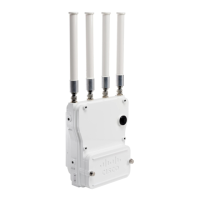3-4
Cisco Wireless ISR and HWIC Access Point Configuration Guide
OL-6415-04
Chapter 3 Configuring Multiple SSIDs
Configuring Multiple SSIDs
Note You use the ssid command’s authentication options to configure an authentication type for each SSID.
See
Chapter 6, “Configuring Authentication Types,” for instructions on configuring authentication
types.
Use the no form of the command to disable the SSID or to disable SSID features.
This example shows how to:
• Name an SSID
• Configure the SSID for RADIUS accounting
• Set the maximum number of client devices that can associate using this SSID to 15
• Assign the SSID to a VLAN
• Assign the SSID to a radio interface
router# configure terminal
router(config)# dot11 ssid batman
router(config-ssid)# accounting accounting-method-list
router(config-ssid)# max-associations 15
router(config-ssid)# vlan 3762
router(config-ssid)# exit
router(config)# interface dot11radio 0
router(config-if)# ssid batman
Step 5
vlan vlan-id (Optional) Assign the SSID to a VLAN on your network. Client
devices that associate using the SSID are grouped into this
VLAN. You can assign only one SSID to a VLAN.
Step 6
guest-mode (Optional) Designate the SSID as your access point’s
guest-mode SSID. The access point includes the SSID in its
beacon and allows associations from client devices that do not
specify an SSID.
Step 7
infrastructure-ssid [optional] (Optional) Designate the SSID as the SSID that other access
points and workgroup bridges use to associate to this access
point. If you do not designate an SSID as the infrastructure
SSID, infrastructure devices can associate to the access point
using any SSID. If you designate an SSID as the infrastructure
SSID, infrastructure devices must associate to the access point
using that SSID unless you also enter the optional keyword.
Step 8
interface dot11radio { 0 | 1 } Enter interface configuration mode for the radio interface to
which you want to assign the SSID. The 2.4-GHz radio is radio
0, and the 5-GHz radio is radio 1.
Step 9
ssid ssid-string Assign the global SSID that you created in Step 2 to the radio
interface.
Step 10
end Return to privileged EXEC mode.
Step 11
copy running-config startup-config (Optional) Save your entries in the configuration file.
Command Purpose
